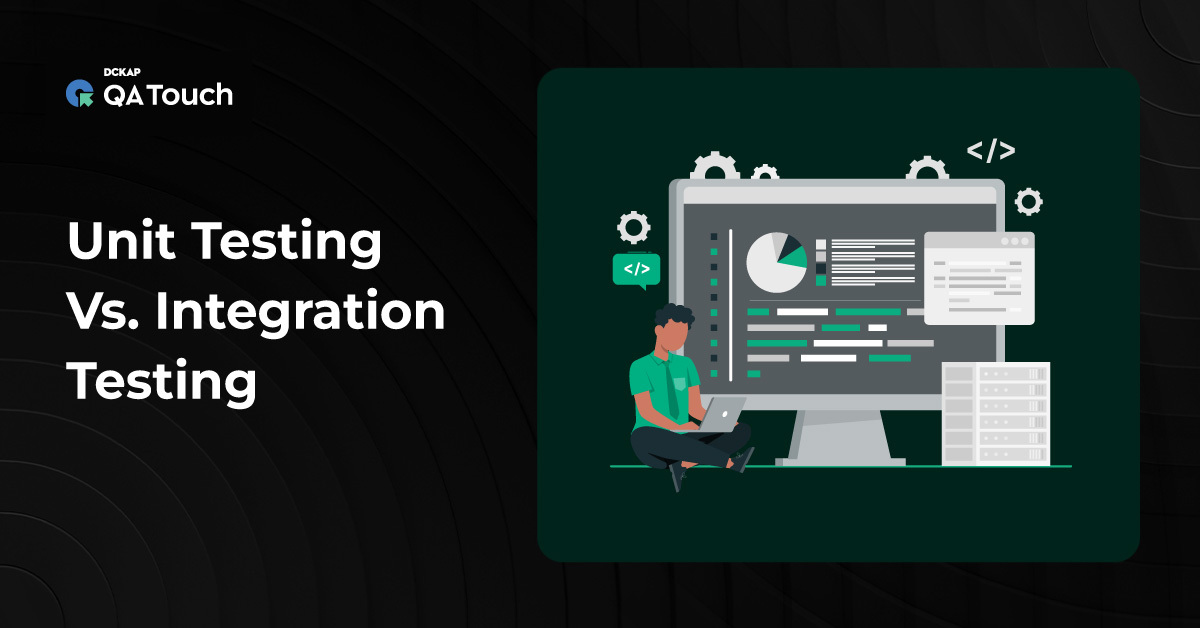APIs (Application Programming Interfaces) are used for data exchange and communication between different software systems. As organizations rely on APIs to deliver services and integrate applications, ensuring these APIs’ functionality, reliability, performance, and security becomes crucial. This is where API testing comes into play.
A report by Fastly suggests that API security problems are the major challenges faced by around 95% of companies. This blog will cover API testing, its types, examples, best practices, and more. Read along!
Table of Contents
What is API testing?
API testing is a software testing technique used to confirm if API is working as expected. It focuses on software functionality and behaviour. Unlike traditional testing methods, which focus on the graphical user interface (GUI), API testing targets the business logic layer of the software architecture. In API testing, requests are sent to the server, and responses are analyzed and verified to determine whether they are correct.
Example of API Testing
Let us take an example to better understand API testing. Imagine you want to transfer money from one bank account to another using an online banking application. In this case, the app uses an API to fetch data regarding the transaction. With API testing, testers can verify that the “Transfer Money” API correctly processes account transactions, maintaining data integrity and security.
Businesses use API testing to check for security vulnerabilities, performance issues, and other potential bugs. API testing fits into the concept of layered testing architecture alongside unit testing and UI testing, as shown in the image below:

Benefits of API testing
API testing offers benefits like:
- Easier test maintenance: API tests are easier to create and manage than UI tests. When the user interface changes, APIs remain stable, so tests do not need frequent updates. As a result, the overall test maintenance effort is reduced.
- Faster validation: API tests are executed quickly because they directly interact with the application’s logic, minimizing the need for dependencies. This faster validation can help developers receive quick feedback for rapid iteration and continuous improvement.
- Quick resolution time: API tests can detect issues early. By identifying and resolving bugs early in the development phase, developers can fix problems before they affect the user interface or end-user experience.
- Enhanced test coverage speed: API testing helps testers create detailed test cases for scenarios that might go unnoticed through UI tests alone.
- Universal Language Understanding: APIs communicate using XML and JSON, making them independent of programming languages. This allows for easier testing using common tools and frameworks regardless of the underlying implementation.
- Quality Assurance: With API testing, organizations can deliver high-quality software, making their customers happy and reducing the risks of big failures.

Relationship between API testing and API monitoring
Now, one must not confuse API testing with API monitoring. Although both these concepts share the same goal, that is, to ensure that API remains stable and performant, they are performed at different stages of the API lifecycle.
API testing is performed in the development phase to ensure there is no issue before it reaches production and impacts users. API monitoring, on the other hand, is performed after the API has been deployed to production.
Types of API testing
By performing API testing, you can ensure your applications function as expected. Here are the different types of API testing that we can perform:
- Functional testing: This type of testing verifies that the API functions correctly according to the defined specifications.
- Validation testing: Validation testing ensures that API meets the functional requirements and performs as expected.
- Performance testing: With performance testing, you can test an API against different loads for its speed and responsiveness.
- Security testing: Security testing identifies potential vulnerabilities and ensures the API is secure against attacks.
- Stress testing or load testing: With load testing, testers can check the API’s performance under high-traffic conditions.
- Reliability testing: Reliability testing evaluates the API’s ability to function consistently over time.
- Penetration testing: This testing simulates attacks to discover security weaknesses.
- Fuzz testing: Fuzz testing sends random data to the API to find unexpected crashes or behavior.
- Unit testing: Unit testing tests individual components of the API for correctness.
- Integration Testing: Integration testing ensures different modules or services interact correctly through the API.
- Contract Testing: Contract testing ensures different software components or services work correctly together by establishing a clear and shared understanding of what each API request and response should look like.
Differences Between API Testing and Unit Testing
API testing is different from unit testing. Here is what makes both these tests different from each other:
| Aspect | API Testing | Unit Testing |
| Definition | Testing the entire API to ensure it functions correctly and interacts with other components. | Process of testing individual units or components for bugs and issues. |
| Purpose | Validates end-to-end functionality, performance, and security of APIs. | Ensures that each unit of the code performs as expected independently. |
| Test Level | Integration and system level. | Component or module level. |
| Dependencies | Requires the API to be integrated with other systems or components. | Tests isolated from other parts of the application. |
| Tools | Postman, SoapUI, JMeter, RestAssured, Swagger, Karate. | JUnit, NUnit, TestNG, xUnit, Mockito. |
| Execution Speed | Typically slower due to the complexity and dependencies. | Generally faster due to the isolated nature of the tests. |
| Data Used | Realistic data sets and multiple data formats. | Typically uses mock or stub data specific to the unit being tested. |
| Frequency of Tests | Often run during integration testing phases and continuous integration. | Run frequently during development, especially in Test-Driven Development (TDD). |
| Error Detection | Identifies issues in the interaction between different systems and their functionalities. | Detects bugs within individual units before they affect the larger system. |
Tools and frameworks for API testing
Here are the different types of tools used for API testing:
- Postman: A popular tool for developing, testing, and monitoring APIs with a user-friendly interface.
- SoapUI: A robust tool for testing SOAP and REST APIs, offering advanced features for functional, security, and load testing.
- JMeter: An open-source tool primarily used for performance and load testing of APIs.
- Swagger: Provides tools for designing, building, and documenting APIs, making it easier to create and test APIs.
- RestAssured: A Java library for testing RESTful web services, offering a domain-specific language for writing tests.
- Karate: A testing framework that combines API testing, UI testing, and performance testing in one, using a simple syntax.
How to perform API testing?
A report suggests that 43% of companies struggle to detect APIs exposing personal or sensitive data.
To begin with API testing, you need to know certain aspects, like the API’s purpose, the application’s workflow, and where the API fits in that workflow. Knowing these basics will help you perform the test efficiently. Next comes the preparation and execution of API testing:
Preparation needed for API testing
Choosing the right tool: To conduct effective API testing, you need to choose the right tool. Depending on your project’s specific needs, you can choose JMeter, Karate, RestAssured, or Postman to perform API testing.
Defining test objectives: The next step involves clearly understanding what you aim to achieve with the API testing. Some objectives might include validating API endpoints, checking data integrity, testing performance under load, using resources, interoperability or ensuring security compliance.
Setting up the testing environment: Once you have defined the test objectives, the next step is creating a controlled environment to run our tests, which includes tasks like:
- Test servers or staging environments that mirror production settings.
- Properly configured databases with test data.
- Access to necessary API documentation and authentication credentials
Writing test scenarios
Developing test cases: You need to create detailed test cases that would cover all the aspects of the API, such as
- Positive Test Cases: This ensures the API works as expected with valid inputs.
- Negative Test Cases: It checks how the API handles invalid inputs and error conditions.
- Edge Cases: It tests boundaries and limits, such as maximum payload sizes or special characters.
Defining assertions: Assertions need to be defined after you have created in-depth test cases. These include conditions to be met for a test to pass. Here are some examples of assertions:
- Status Code Assertions: Verify that the API returns the correct HTTP status codes (e.g., 200 OK, 404 Not Found).
- Response Body Assertions: Check that the response body contains the expected data.
- Header Assertions: Validate the presence and correctness of specific HTTP headers.
Mocking external dependencies: If your API relies on external services, we must use mocking to simulate those dependencies. Several tools, like WireMock, can help us create mock responses for testing purposes without depending on the actual external services.
Interacting with the API
Sending requests: To interact with the API, you need to send HTTP requests to the API endpoints. For instance, in Postman, you can configure the request method (GET, POST, PUT, DELETE), set headers, and include request bodies.
Parameterizing tests: You must also configure the tests to run with different input values. This is helpful in ensuring that API can handle a variety of inputs correctly. You also need to ensure that the tests include the necessary authentication steps, including OAuth tokens, API keys, or basic authentication headers.
Validating test results
Analyzing responses: Finally, examine the API responses to ensure they meet the expected results, such as:
- Response Codes: Verify that the API returns the correct HTTP status codes.
- Response Body: Check the content of the response body for accuracy.
- Headers: Validate that response headers contain the expected values and properties.
Logging results: Once you have the results, you can capture detailed logs of the test execution, including both request and response details. This will be beneficial during debugging, providing a clear record of what was tested.
Make sure you have a process for documenting and handling errors and exceptions in case the test fails due to bugs or issues.
Automating and integrating tests
Automating the test with automated testing tools can help with faster test execution. API tests can also be integrated with CI/CD pipelines. This ensures that tests are run with every code change, thereby helping you catch issues early and maintain high-quality software.
Best Practices for API Testing
Here are a few best practices to keep in mind when performing API testing:
- Develop thorough test cases that include all possible scenarios, including edge cases.
- Use automation tools to run tests frequently and consistently, ensuring that new code changes do not break existing functionality.
- Integrate API testing into the CI/CD pipeline to catch issues early and ensure continuous quality.
- Keep detailed documentation of your API tests, including test cases, scripts, and results.
- Test both valid and invalid inputs to ensure the API handles all scenarios gracefully.
Common API Testing Mistakes to Avoid
- Invalid fields: Accuracy is crucial when passing data to API. If the endpoint documentation is not thoroughly reviewed to confirm the correctness of the data, specific error messages might appear. As a result, you need to train your API correctly.
- Use of non-standardized practices: Following non-standardized practices can cause issues, particularly in publicly consumed APIs. Therefore, proper instructions on test guidelines need to be formatted. This helps developers stay aligned with what needs to be done and how.
- Errant entries: When a piece of code is wrongly defined, it leads to an errant entry, which can cause functionality issues. Continuous testing can help you identify and resolve errant entries early.
- Lack of effective communication: Since many teams are involved in software development, there is a chance of communication breakdowns leading to misinformation. Maintaining and following a detailed shared development plan and updating it in real time can help develop effective communication.
- Easy readability: Poorly documented test cases and scripts can lead to confusion and errors. It is crucial to use languages and characters that are easily understood by others.
What Exactly Do We Check During API Testing?
QA testers can evaluate the following things when performing API testing:
- Missing or duplicate functionality
- Reliability issues
- Data Accuracy
- Response time
- Authorization checks
- Multithreaded issues
- Error codes if API returns
- Performance and security issues
API Testing Case Studies
Various established organizations are using API testing. Here’s how Netflix utilized API testing for a successful user experience:
The Netflix API is crucial in managing the catalog and subscriber metadata between internal services and Netflix applications on various device types. Since a large number of devices are involved, any failure within the internal services could potentially disrupt the API, leading to a degraded user experience. To ensure continuous, high-quality streaming for users, it was essential to maintain the API’s high availability and resilience, even under the strain of handling a billion requests daily. This is why Netflix adopted API testing to detect and mitigate real-time failures.
Some of the key principles that motivated Netflix to enhance its API resilience are:
- A failure in a service dependency should not disrupt the user experience.
- The API should automatically implement corrective measures when a service dependency fails.
- The API should provide real-time visibility into current operations and historical data from 15–30 minutes ago, yesterday, last week, and beyond.
By implementing comprehensive API testing, Netflix maintained a seamless streaming experience for its users, even during peak traffic hours. Their testing approach helps identify and address potential issues, thereby enhancing user experience and ensuring high customer satisfaction and retention levels. You can read more about how they did it in this article.
Challenges of API Testing

Handling Asynchronous Operations: Testing asynchronous operations can be challenging due to the unpredictable timing of responses. To address this, we must use tools that support asynchronous testing and implement appropriate wait mechanisms.
Managing Test Data: Maintaining consistent and reliable test data for large-scale APIs can be challenging. Data management strategies, such as using mock data or setting up dedicated test environments, can help overcome this.
Ensuring Security: Ensuring API security is an ongoing challenge. We must regularly update our security tests to protect against emerging threats and vulnerabilities.
Dealing with API Versioning: Testing different versions of an API and ensuring backward compatibility can be complex. For this, we must implement versioning strategies and maintain separate test suites for each API version.
Future Trends in API Testing
AI and Machine Learning
62% of companies believe AI will greatly impact the growth of newly identified API vulnerabilities. AI and ML technologies are integrated into API testing tools to automate test case generation, enhance test coverage, and improve defect detection. These technologies analyze large data sets to identify patterns, anomalies, and potential areas for optimization, leading to effective testing processes. Curious to know more about AI testing? We have written a detailed guide on how AI is used in software testing.
Shift-Left Testing
The trend towards shifting testing activities earlier in the software development lifecycle (SDLC) continues to gain momentum. By integrating API testing into the development process from the outset, teams can identify and solve issues earlier, thereby saving cost and effort. This approach improves collaboration between developers and testers, fosters a quality culture, and accelerates market time.
Shift-Right Testing
In addition to shifting testing left, there is also demand for shift-right testing, which focuses on monitoring and testing applications in production environments. By continuously monitoring APIs in production, organizations can proactively identify issues, gather real-world performance data, and prioritize areas for improvement. Shift-right testing complements traditional testing approaches and helps ensure that applications meet user expectations and deliver a seamless user experience.
API Test Automation
Automation remains a key focus in API testing, with organizations increasingly adopting automated testing tools and frameworks to streamline testing processes. Automation enables teams to execute tests quickly and consistently, ensuring comprehensive coverage and faster feedback. Continuous integration/continuous deployment (CI/CD) pipelines further facilitate automated testing by seamlessly integrating API tests into the development workflow.
Security Testing
The surge in APIs and rising concerns about data security are driving the need for stronger API security testing. This has led to integrating security testing tools and techniques into the API testing process. Additionally, a growing focus is on securing APIs against emerging threats, such as API abuse, data breaches, and injection attacks.
API Virtualization
Another emerging trend in AI testing is API virtualization which enables teams to create virtualized versions of APIs for testing purposes. Virtual APIs mimic the behavior of real APIs, allowing testers to validate application functionality, simulate different scenarios, and test integrations without relying on external dependencies. API virtualization reduces testing constraints, accelerates testing cycles, and improves test coverage.
Conclusion
API testing is crucial for organizations to ensure the APIs function correctly and remain secure. This testing helps detect bugs early, thereby saving the risk of potential big failures and optimizing the software’s performance.
QA Touch is a test management software that lets you create, organize, and manage test cases for API testing. You can define test cases for different API endpoints to specify the request parameters, expected responses, and any preconditions. Additionally, with its integration features, popular API automation tools can be integrated, allowing you to run API from a single platform.
Explore how QA Touch can help you streamline API testing by logging in here. QA touch platform is free to use until you are ready to upgrade.
If you have any questions, feel free to reach out.










